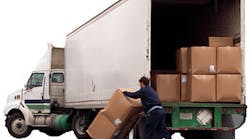The commonly accepted market TL rate does not actually exist, according to by Dr. Chris Caplice, executive director, MIT Center for Transportation and Logistics.
Caplice said it misrepresents the true nature of TL transportation, and is not a true market rate as such.
He cites, in an MIT e-newsletter. three main reasons why the traditional TL rate is difficult to pin down.
First, it is hard to find comparable networks. TL networks are naturally sparse and tend to be unique to each firm. A recent analysis carried out by supply chain consulting firm Chainalytics of more than 100 shippers with over $10 billion in annual TL spend found very little overlap. For example, less than 3% of the lanes (defined as a 5 to 5 digit postal code) in the studied network for dry van truckload movements had two or more shippers hauling on them. So, the probability of finding other shippers with identical lanes is exceptionally low.
Second, there is the issue of confidentiality. Most shippers have implicit (or even explicit) confidentiality conditions with their carriers that prevent them from direct sharing of their TL rates.
The third and most important reason why these simple, lane-based market rates are hard to obtain is because they are a myth! In 20 years of analyzing and working in the trucking market, I have never found a lane where a single TL rate applies to all shippers. The market is too dynamic and the underlying cost drivers extend beyond simple geography.
Caplice’s recommendation is to develop a market rate for a specific shipper on a lane. Instead of simply averaging the outcomes (the lane rates), the shipper decomposes the transportation cost inputs, analyzes, isolates, and quantifies each of the individual cost drivers that in turn dictate the transportation rates.
The method isolates each driver rather than blending variables. He prefers this as it allows a company to price out different policies and practices. Individual shipper policies can account for more than 10% of the variability of TL rates.
An econometric approach takes these differences into account so that, for example, we can determine the additional cost of delivering to a customer as opposed to an inter-plant move. We know how much multi-stop movements implicitly increase rates – over and above any accessorial or stop-off charges. We know the rate impact of increased corridor volumes. Additionally, this modeling approach lets us determine the TL rate impact of drop-and-hook versus live load/unload, 30- versus 60- versus 90-day payment terms, hazmat shipments, etc. Each shipper has its own fingerprint.
Second, this approach allows us to develop more robust models and make wider comparisons. By decomposing the transportation function, we have solved both the problem of sparse TL networks and rate confidentiality. An econometric-based model does not compare lane rates; it separates out the individual effects, to include the origin and destination locations. While shippers have very low lane overlap, they have very high region overlap. We exploit and leverage this by calculating the impact of loading (unloading) in different geographic regions. The model is able to accurately estimate the geographic cost impact of each 3-digit postal code region.
More on this topic by Caplice on the Supply Chain @ MIT Blog, part one and two.



